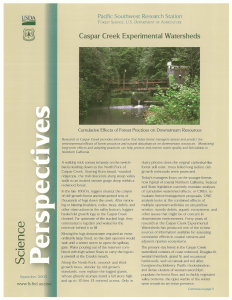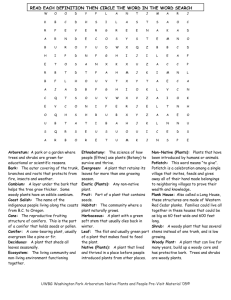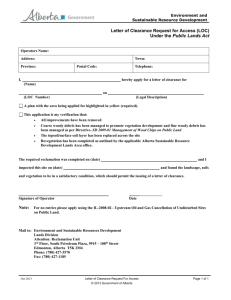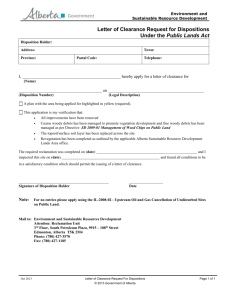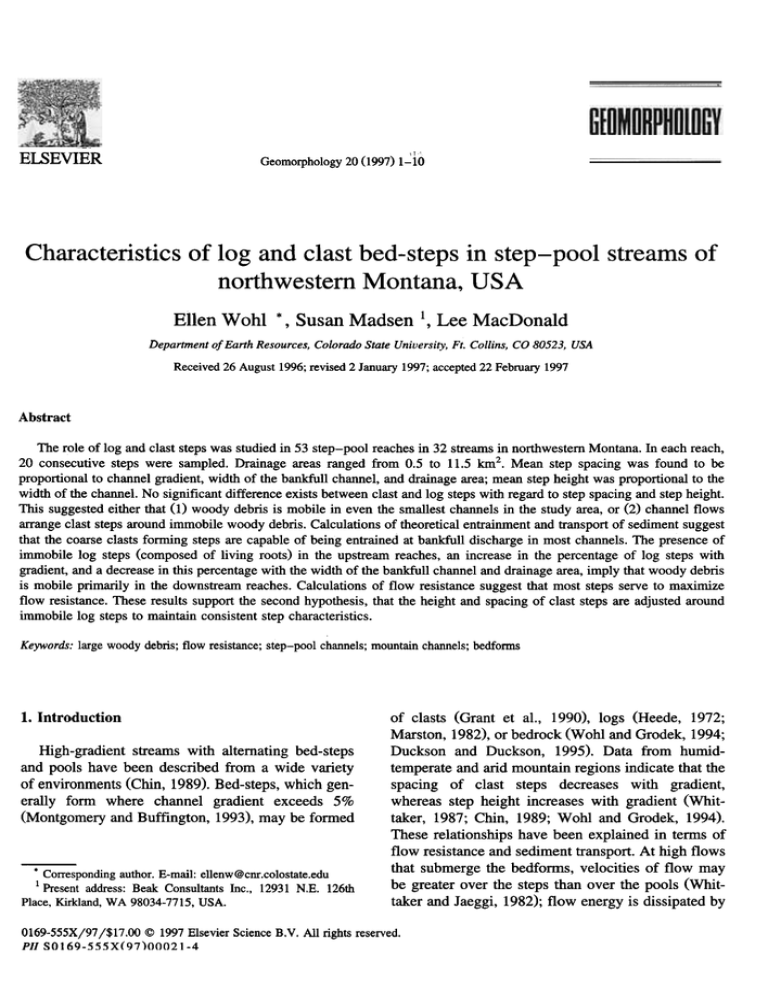
ELSEVIER
Geomorphology 20 (1997) l-':io
Characteristicsof log and clast bed-stepsin step-pool streamsof
northwesternMontana, USA
Ellen Wohl
*,
SusanMadsen 1, Lee MacDonald
Department of Earth Resources, Colorado State University, Ft. Collins, CO 80523, USA
Received 26 August 1996; revised 2 January 1997; accepted 22 February 1997
Abstract
The role of log andclast stepswas studiedin 53 step-pool reachesin 32 streamsin northwesternMontana.In eachreach,
20 consecutivesteps were sampled.Drainage areasranged from 0.5 to 11.5 km2. Mean step spacingwas found to be
proportionalto channelgradient,width of the bankfull channel,and drainagearea;meanstepheight was proportionalto the
width of the channel.No significantdifferenceexistsbetweenclast and log stepswith regardto stepspacingand stepheight.
This suggestedeither that (1) woody debris is mobile in even the smallestchannelsin the study area,or (2) channelflows
arrangeclast stepsaroundimmobile woody debris.Calculationsof theoreticalentrainmentand transportof sedimentsuggest
that the coarseclastsforming stepsare capableof being entrainedat bankfull dischargein most channels.The presenceof
immobile log steps(composedof living roots) in the upstreamreaches,an increasein the percentageof log stepswith
gradient,and a decreasein this percentagewith the width of the bankfull channeland drainagearea,imply that woody debris
is mobile primarily in the downstreamreaches.Calculationsof flow resistancesuggestthat most stepsserveto maximize
flow resistance.Theseresults supportthe secondhypothesis,that the height and spacingof clast stepsare adjustedaround
immobile log stepsto maintain consistentstep characteristics.
Keywords: large woody debris; flow resistance; step-pool channels; mountain channels; bedforms
1. Introduction
High-gradientstreamswith alternating bed-steps
and pools have been describedfrom a wide variety
of environments(Chin, 1989).Bed-steps,which generally form where channel gradient exceeds 5%
(Montgomeryand Buffington, 1993),may be formed
.
Corresponding author. E-mail: ellenw@cnr.colostate.edu
1
Present address: Beak Consultants Inc., 12931 N.E. 126th
Place, Kirkland, WA 98034-7715, USA.
of clasts (Grant et al., 1990), logs (Heede, 1972;
Marston, 1982),or bedrock(Wohl andGrodek, 1994;
Duckson and Duckson, 1995). Data from humidtemperateand arid mountainregionsindicatethat the
spacing of clast steps decreaseswith gradient,
whereasstep height increaseswith gradient (Whittaker, 1987; Chin, 1989; Wohl and Grodek, 1994).
Theserelationshipshave been explainedin terms of
flow resistanceand sedimenttransport.At high flows
that submergethe bedforms,velocities of flow may
be greaterover the stepsthan over the pools (Whittaker and Jaeggi,1982);flow energyis dissipatedby
0169-555Xj97j$17.00
@ 1997 Elsevier Science B.Y. All rights reserved.
PII SOI69-555X(97)OOO21-4
U~IA\
.A.IO:jSIQ~sn-pUt!I
pUt! 'S~ss~~old ~IQdJOUlO~~
pUt! A~OIOq:lII 'SI°I}UO~ ~n~UlII~ Aq P~YI:j~I}S ~l~M
suI~H .suon~~oI ~uIIdurns ~SI~~ld ~q:I pUt! p~!pmS
~q O:j suIs~q ~q:I ~UIAJI:jU~PI 10J Ul~:jSASuoI:j~~YIss~I~
~~~~m1~IQ U p~sn ~M 1~~r01d :jUq:l10d lS~lOd ~Uon
-uN IUU~:jOO)l ~q:I uo sPIoQs~Jq:I PI~IA-1~:jUM ss~ssu
O:j P~u~IS~P :j~~r01d l~~mI ~ JO :jlP.d SUM :>110MS~J,
spoq1aw "£
'(~661 'UUUIJJOHpu~ Pl~uOa:)~W) ~~m ApmS ~q~
JO 1JUdW~~S~M ~tp u! SMOY ~~d ~s~gml ~tp ~~~l~U~g
S~U~A~MOUS-UO-U!t!ll~~U!MP!UI ~nq '~I~UIMOUSgu!lds
Jo ~lns~l ~ S~ ~unf puu A~W U! In:):)O Al~nsn SMOY
~~d
'p~g~gun Al~sOUI ~m Sp~qSl~~~M ~~
'Sl~A!l
){lOd S){ml;) 10 !t!U~~OO)l ~tp ~!A l~Arn ~!qUInl°;)
l~ddn ~tp O~ Am~nq~ ~m pUU 'zUDI ~'11 O~ ~'O
JO s~~m ~g~U!t!lp ~A~q ~~m Apn~S ~tp U! Sp~qSl~~~M
~~
'SU°!1~A~I~ l~ddn ~tp ~~ UI:) O~Z O~ SA~I~A
~tp U! UI:) O~ UIOIJ gU!S~~l:)U! UO!1~!d!:)~ld tp!M
'~~RWn:J ~Wn!lRW JR~U~UnUO:J
R SRq R~m ~ql °UO!~R~
-~~~A ~URU!W°P ~q:I S! ~S~lOJSnOl~J!UO:JpUR 'w OOt?Z
O~ O~~ wall
~~URl UO!~~l ~q:I U! SUOnRA~13 0(8t?61
'oJR ~~ uosq!O) SA~IJRA JRU!I:JUASMOllRU Aq p~~Rl
-Rd~s S~~URl u!R~unow JRU!I:JnUR~U!PU~II ~S~Mq1JOU
-q1J°u p~:Jnpold :J!ozou~J Alm~ o~ :J!OZOS~W~~RI~q:I
wall
UO!SS~ldwo:J JRUO!~~"Mo~~~qS ~:JI URl~Il!PloJ
~u~:Jo~S!~ld ~q:I wall s~!sod~p JR!:JRI~Aq U!RJl~AO's~p
-~S ~I~H ~q:I Jo S){:JOl AlmU~W!p~SR~~W URpqWt!:J~ld
Aq p~~RU!W°P S! UO!~~l ~q:I Jo A~OIO~~ ~qJ. 0(1 O~!d)
RUR~UOWW~~S~Mq1JOUU! ~s~lod JRuO!~RN!Ru~~oo)I
~q:I U! P~~R:J°I ~m q:J~M Jo IJR Alm~u 'SI~UURq:JZ£
UO S~q:JR~llood-d~~s £~ Jo S~S!suo:J~~s R~Rps!qj.
83.18 PI3!.!I "'
':JJodSUUJ1
puu ~u~m
-U~J1u~ ~u~m!p~s IT!~!~~10~~ 10 Suo!~uln~IT!~ q~noJq:l
At!I!qom ~sul~ puu ~01 ~U!SS~SSUpuu 's~lqu!lUA
l~uuuq~ puu S~!~s!l~~~uJUq~d~~s U~~M~~q suo~ul~llo~
~~ ~ununIT!A~ puu ~U!~S~~ 'Pl~Y ~~. U! s~~s!l~~~u
-JUq~ d~~s puu q~U~l ~u!lnsu~m Aq s~S~~OdAq ~s~~
p~~s~~~A\ 's~~s!l~~~uJUq~ d~~s ~U~~S!SUO~
u~~u~m o~
sd~s ~01 ~1!qounu! punoJU sd~~s ~sul~ ~~uulJU SMOg
l~uuuq~ (Z) 10 'U~JU ApmS ~~ U! sl~uuuq~ ~s~lIT!ms
~~ U~A~ U! ~1!qom S! S!lq~p ApOOM (I) 1~~!~ U~~
'~lquqS!n~U~SWU! AIIT!~~S~U~S~q O~p~A01d sd~~s ~01
pUU ~sul~ 10 ~q~!~q puu ~u!~uds ~~ 1! '~u~ p~UOSU~l
~A\ 'UUU:luoW W~~S~Mq:JJOUU! sl~uuuq~ Z£ ~UOIT!
S~OI puu s~sul~ 10 p~sodmo~ sd~~s-p~q p~u!Un!x~ ~A\
~
IS'101l
\1'UO!~"
P"'q~"11l
)
~S'JOiI ~UO!~~N !~u,~oo)l
~
.
I
~~qq!l
'. (
(
::.
.~
""'!if~\
.
\
'(17661 'puomq~rn
~q'u0661 'U1q~s~H puu UOS!q°"M
~L861 "IT! ~~ UOSS!H~1861 '~P~~H) l~uuuq~ ~~ ~UOIT!
suo~u~ol mopuu1 ~u S~~p~M ~u~mw~s 10 sd~s SUll01
~101~1~~ q~!I1M 'S!lq~p ApOOM ~~JUI :JJodSUUJ1
O~~U~
-~dmo~ ~OU~JU sl~uuuq~ 1~p10-MOl U! SMOg ~~ ~U~
p~pnl~uo~ ~AUq SlO~nU IT!l~A~S '~SUJ1UO~UI "(0661
"IT! ~~ ~UU1D) SMOg q~!q ~U!lnP :JJodSUUJ1
~u~mw~s
O~ p~~nq!J1~u AIIT!l~U~~ ~JU sd~~s-p~q ~suD "(1861
'~P~~H) 1~~~~0~ Jn~~O u~Uo sd~~s 10 s~dAt OM~
~s~~ s~u~mq~~u~u~~unom p~~s~101U! ~u~ P~uo!~u~m
~Auq sl~dud M~1 'sd~~s-p~q ~01 10 sd~~s-p~q ~SU1~
.
:
1~~!~ p~U!Un!X~ ~AUq S~wmS IT!l~A~S q~no~IV
"(6861 'U!I1;) sum~J1S~U~WU1~
!
.. . ... .
...
yN
.i
-Mol 'IT!!AnnU U! S~U~UJ1SnrpU
IT!l~~Ul ~!M P~~U!~OSSU
UO~Ud!SSWA~l~U~ ~~ O~ sno~OIT!UU~q AUm sum~~s
VNV:>
iMo911
N06t
Ol-l
(L66l)
u~unom
P~UYUO~ U! SUll01P~q 100d-d~~s 10 ~101
~tU "(0861 'PJUMAUH) Slood ~~ U! ~U!x]1U ~u~lnq1m
O'l laorOlfdtOIUO;1D /1TJ J;1IlfoM
.:!J
~
E. Wohl etal./Geomorphology 20 (1997J1-10
(a)
Spacing
Distance
(b)
Downstream
Spacing
Distance downstream
Fig. 2. Schematicdiagram of step-pool measurements(not to
scale).
eachbasin, study reachesextendingfrom the headwaters to the mouth of the basin were selectedto
representa range of drainage areas and channel
gradients.Three to six reaches30-60 m long were
identified within eachbasin dependingon basin size,
homogeneity of the valley bottom, and gradient
changes.In eachreach, we surveyedchannelgradient and two channel cross-sections,and measured
channelbedforms,percentof exposedbank, woody
debris, and the grain-size distributions of the bed
materialin the stepand pool bedforms.
For each of the 53 study reaches,downstream
spacingand height of 20 consecutivebed-stepswere
measured.Channelgradientwas surveyedalong the
reach using a stadiarod and transit level, and distancefrom the baseof eachstep-treadto the edgeof
the next step-treadwas measuredwith a metric tape
(Fig. 2). Height was measuredfrom the edgeto the
base of the tread. Intermediate(b-axis) diameters
were measuredfor clastsidentified as integral componentsof the step,and an averagesize of step-forming clast was calculatedfor eachreach.In addition,
we measuredthe intermediateaxis of 100 particles
collected systematicallyacrossthe bankfull channel
(Wolman, 1954) at (1) multiple steps within the
reach,and (2) multiple pools within the reach.If the
step was formed by large woody debris, the diameters of the woody debris were measured,and the
clasts forming the step substratearound the wood
were measured.The stepsformed by woody debris
included: single logs perpendicularto the channel
and partly buried by cobble-to-gravel-sizedclasts
(Fig. 2b); logs attachedto one bank that formed a
ramp down to the channelbed perpendicularto flow;
and roots crossingthe channelperpendicularto flow.
Clastsforming the surfaceof the channelbed at log
stepswere generally smaller in diameterthan those
forming clast steps.
Data from the surveyedchannelswere used with
the softwareprogramXSPRO(Grant et al., 1992)to
estimatehydraulic variables (velocity, shear stress,
streampower per unit area) for bankfull flow. Dimensionsof bankfull channelswere designatedin
the field on the basisof changesin bank slope,grain
size, and vegetation.The calculatedhydraulic variables were in turn used to estimate proximity to
entrainmentthresholdsfor the D84 clast size at each
cross-sectionusing two setsof equations:
Tc= O.17d
(1)
Wc= O.O79d1.3
(2)
= O.O56d1.213
(3)
Tc
Wc
= O.OO9d1.686
(4)
where Tc is critical shearstress(N/m2), and Wcis
critical streampower per unit area(W 1m2), and d is
clast size (mm). Eqs. (1) and (2) representthe lower
limiting line on plots of entrainedparticle sizeversus
hydraulic variables,using a large datasetculled from
the literature by Williams (1983). Eqs. (3) and (4)
describethe best-fit least-squares
curve for a dataset
from high-gradientchannelsin the Colorado Front
Range(Costa, 1983).
The hydraulic variables calculatedwith XSPRO
were also usedto estimatethe transportof sediment
at bankfull discharge with the Meyer-Peter and
Muller equation for bedload, as modified for highgradientstreams(Smart, 1984).
Ol-l
(L66l) Ol.{Eo/OIfdtOUlOilD /"lv Iii/if oM .a
sd~~s gufUDOJ s!Jq~p
.(U~up P~gUJ~AU-q:>U~J)
f.pOOM JO J~~~W1!!P JO ;IZ!S ~Sl1I:> SnSJ~A
gU!:>uds d~~s-P~1I (q) .(U~up PagUJ~AU-q:>U~J) sd~s
gU!UJJoJ s!Jq~p
f.pOOM JO J~~W1!!p JO ~Z!S ~suI:> SnSJ~A ~qg!~q d~~s-P~1I (U) .v .g!d
I J8j8W8IP501 +
(w)
0'9
g:v
O:V
g:s
BU!"Bde
OS
+ .1;
+
ezlS ISep
-~s
uuoJ!Unuou
~q'2!;}M
%06
q:)~M
06p ':jlodsUt!~
1! JO ' AI;}An:)~S;}l
lOJ 1;}~;}~!P
'~q'2!;}M %0£
U!t!l'2
~U;}W!p;}S SS;}JUO!SU;}w!p
;}m
pUt!
OEp pUt!
S! <1> ;}l;}qM
.
g'~
0'1
S'O
~~. -_:_,.._,_~jO,
0'0
..
gu!:mds
d:)~s-~
snsJ:)A IpP!M
-J:)AI1-q:m:)J) gU!;)l1ds d:)1s-~
+ +
+ +
.
.(~I1P p:)gI1J:)AI1-q:m:)J) ~qg!:)q
SnSJ:)A IpP!M I:)UU\1q;) llnJ:J[U1Jg (;) "(~l1p p:)g\1J:)AI1-q;)I1:)J)
d:)1s-~
pee
O~
,-~
, O~
..:
.+
.+
dele
g'~
-,-_.:_,-'
+
+
-
.++
re
..+
-}
I:)UU\1q;) llnJ:J[U1Jg (q)
"(~l1p ~gl1
SnSJ:)A ~U:)!p1!~ I:)UU\1q;) (11) .£ .g!d
Q
I
~
..
,,"
..
-0
3
de18Boi +
d818lseF'.
I
'.8
-'"
~
0.
:'1
-f"
09
~"
~
~
-0
a.
--+
"
--+
-1-
(q)
-++
~o
.
+
-
"'
~
-+
.-+++
.~
LQ9
vO ~
+
..
."
"
m.
"'
~
9.0 3:
:[
8.0
(:»
~I
r
q:I!M P;}:IB!:)OSSB SJOJJ;} ;}Z!W!U!W
0:1 J;}pJO U! S{;}UUBq:)
:IS;}:Iq~!BJ:lS ':IS;}~m{ ;}q:I WOlJ SUon:);}S-SSOJ:) ;}Soq:)
;}A\ .S;}q:)B;}J {;}UUBq:) 9 { WOlJ SUon:);}S-SSOJ:) d;}:js 9 {
pUB SUon:);}S-SSOJ:) {ood 17{ 10 ~U!:IS!SUO:) 'B:lup ;}q:l1°
:I;}sqns ;}AnB:lu;}S;}Jd;}J B 0:1 SUO!:IBnOO ;}S;}q:I p;}!{ddB ;}A\
(%) juelpeJB
r
-U!BJ:lU;} W;}W!P;}S J01 ;}:IBWnS;} ;}pm!U~BW-10-J;}pJO
UB ':IS;}q :IB .;}P!AOJd SUonBnb;} ;}S;}q:I .{UJ;}U;}~ UJ
(2
.S{;}UUBq:) {ood-d;}:IS
10 s:)nnBlpAq
X;}{dWO:) ;}q:I J01
P;}U~!S;}P :I0U ;}J;}M A;}q:I ;}SnB:);}q .:jJOdsUBJ:I pUB W;}W
SS;}{U°!SU;}W!p
S!
(}
.(~.o(SH8
)/11 = )
.~
~,~
+
.(17861 .:jJBWS) t;.8 UBq:I SS;}{ O£p/06p °nBJ UO!:1
-nq!J:Is!p ;}Z!S-U!BJ~ B pBq SW;}W!P;}S pUB .%OZ UBq:I
SS;}{ ;}J;}M S;}do{S ;}SnB:);}q (t;) .h3 J01 sw;}w;}1!nb;}J
+
.
~uue4:)
~~
.
~
+
s.~ ~
+ .~
"',jl
60'
;}q:I
P;}1JS!:IBSB:lBP BUB:IUOW ;}qL "{t;o.o 0:1 £0.0) J;}:1;}UJBmd
S,P{;}~S {U:)n!.I:) S! JJ(} pUB .(P{I -S)/
SH = ) SS;}J:lS
m;}qs
+ ...~
..~
.~
~
.~ ,w
& ~
-'
i (9)
.~
jOO.L
..~
..3 +
~~
JO:1:)B1
.-
.c-
(
;}:)UB:lS!S;}J MO{J S! .J 'OOo{S {;}UUBq:) S! S .J;}U1J S! ;}{d
Ol-l (L66l)O~.{JI°I°l{dtoUloilD/'IVli11l{°M '3
~,~ of
~
P~Z!S-T~At!J~Jo p~sodwo:J Sd~1SJ~AO S~!1!:J°T~AMOTJ
J~1t!~J~ p~JnSlJ~W OqM '(Z861) !~~~t!f pUt! J~){t!11~
Jo )fJOM 1t11u~w!l~dx~ ~q:I 1:J!pt!IIuO:J s1Tns~J ~s~~
"SToodJ~AO S~9!:J°T~A MOTJJ~1t!~J&~q:I wol] P~1:J~dx~
~q PTnoM st! '(8 "~!d) STood ~q1 J~AO 1t!q:IJo %~~ s~~t!
-J~At! Sd~1S~q:I J~AO :JJodsUt!II1u~wW~s p~1t!Tn:J1t1;)
"(L O~!d) sT~UUt!q:J
1S0W U! ~~Jt!q:JS!P IInJ){Ut!q 1t! p~U!1!IIU~ ~q Ut!:J Sd~1S
pUt! STood JoJ PSa pUt! S1St!T:J
~u!WJ°J-d~1S ~q:I 1t!q:I
~1t!:JWU!su09t!Tn:J1t1:J
1u~UJU!1!IIu~~~ "(9 O~!d) S1unO:J
1st!T:J-00I ~q:I JoJ s~n1t1At8a ~q:I Ut!q:I J~~Jt!TAT1t1J~U~~
~J~M s1st!T:J~u!WJoJ-d~1S Jo SJ~~UJt!W Ut!~w ~~
"(:J~ "~!d) ~st!~J:J~p (6£"0- =.l)
t!~Jt! ~~t!U!1!lp pUt! (q~ "~!d) (L£OO- =.l) T~uUt!q:J
IInJ){Ut!q Jo q1P!M St! pUt! '(t!~ O~!d) (0£00 =.l) s~st!~J:J
-U! 1u~Wt!J~ st! s~st!~J:JU! S~oT Aq p~UJJoJ sd~1s-p~q
JO ~~t!1u~:JJ~d ~~
"(qp O~!d) (OZ'O =.l) J~~UJt!!P
~OTq:I!M 10U 1nq '(9Z'O =.l) J~1~UJt!W1St!T:Jq:I!M P~1t!T
-~JJO:J AT~A!1!Sod S! ~u!:Jt!ds d~1S St!~J~qM '(t!p O~!d)
Sd~1S ~q:I ~u!WJoJ (LloO=.l)
s~OT pUt! (LL'O=.l)
s1st!T:Jq:loq Jo SJ~1~UJt!W~q:I q:I!M P~1t!T~JJo:JAT~A9
-!sod S! 1q~!~q d~1S lU~J~JJW ApUt!:JY!U~!S 10U ~Jt!
sd~1s-p~q Jo S~dA1 OM1 ~s~q:I Jo 1q~!~q pUt! ~u!:Jt!ds
Ut!~w ~q:I 1t!q:I P~1t!:JWU!S1S~-t pUt! 's~q:Jt!~J T~UUt!q:J
~s~q:I 1noq~noJq:l p~x!W ~Jt! sd~1s 1st!T:JpUt! ~O'l
°t!~Jt! ~~t!u!1!lp JO 1U~Wt!J~ T~uUt!q:J
q:I!M 10U 1nq '(:J£ O~!d) q:lP!M IInP1Ul!q q:I!M P~1t!T
-~JJO:JAT~A!1!Sod S! 1q~!~q d~1S Ut!~w 't!~Jt! ~~t!u!1!lp
pUt! (q£ O~!d) q:lP!M T~uUt!q:J IInJ){Ut!q q:I!M P~1t!T
-~JJO:JAT~A9!Sod pUt! '(t!£ O~!d) 1U~Wt!J&T~UUt!q:Jq:I!M
P~1t!T~JJo:JAT~SJ~AU!S! ~u!:Jt!ds d~1S Ut!~w 'SUJt!~IIS
Tood-d~1S 1t1Jn1t!UJo A1!T!qt!!JUA 1U~J~qu! q~]:-q ~q:I
JO U09!U~0:J~J U! su09t!T~JJo:J ~s~q:I JoJ p~sn S! 01'0
Jo T~A~T~:Jut!:JY!U~!S V °S~Tqt!!JUA:J!Tnt!lpAq ~q:I pUt!
d~s ~q:I u~~M1~q SUO!1t!T~JJo:J
~q:I SMOqS 1 ~lqt!l
S:Jlns'a}J '17
"U
~
~
.8"
'~dOlS l~uURq:> S! S pUR
'q:I~u~1 d~~s UR~UI S! 7 '~q~!~q d~~s UR~UI S! H ~J~qM
'(~66I)
'YU~~ S~~JqV
Jo S/7/H
O!~t!J~q:I (Z) pUR
~q:I~U~1q:>t!~J ~q:I Aq P~P!A!P ~q~!~q d~~s ~Ant!lnum:>
~q:I S! a ~J~qM 'a '(~96I)
~sn°'M Jo JO~:>t!Juon
-t!J:jU~:>UO:>
ss~uq~noJ ~q:I (I) :~u!sn ~:>UR~S!S~J
Moll
uo sd~~s-p~q JO s~:>~JJ~~q:I p~~t!nYUA~~M 'AlYUU!d
'SUI~~SAS100d-d~~s O~sl~uURq:>
~U~!pt!~
0[-[
J~MOI JOJ p~dOl~A~P suo!~t!nb~ ~U~Alddt!
(L66T) nl ,{JioIOlidtOUiOiJ!>
/ °IV1iJlUOM '"
E. Wohl et al.j Geomorphology20 (1997) 1-10
clasts. The much larger size of the step-forming
clastsrelativeto either stepor pool DS4valuesalong
the study reachessuggeststhat the steps are rela-
7
tively stablefeatures.This is supportedby magnetic
tracerexperimentsalong other step-pool channelsof
comparabledrainagearea,channelgradient,andclast
>()
c
Q)
:J
0Q)
It
,
25
75
,
125
,
,
,
,
,
,
,
,
175 225 275 325 375
Meanstep
425
forming clast size (mm)
>u
c
Q)
:J
0Q)
It
- ,
25
75
125
'175
225
275
325
375
425
Mean 084 (mm)
Fig. 6. (a) Grain-size frequency distribution for the mean size of clasts that are integral components of the steps in a study reach, in mm
(reach-averaged data). Mean for entire population is 239.1 mm, standard deviation is 70.7; sample size is 53. (b) Grain-size frequency
distribution for D84 determined from 100 clasts sampled at multiple steps in a study reach, in mm (reach-averaged data). Mean for entire
population is 157.3 mm, standard deviation is 72.7; sample size is 53.
-mus m.J°J!Unuou n JO 'AI~A!1:J~ds~1 '1q~!~M %0£ pun
1q~!~M %06 q:J~M IOJ 1~1~mu!P U~l~
~m OEp pun
06p ':jlodsunJJ 1u~mw~s SS~IUO!su~Ul!P S! <1>~1~qM
d~s-p~
"(1!}11P~2111;jA11-q;)11;jl) 1q2!;jq
SnSl;jA qtP!M j;jUU11q;) IInPJU11H (;) "(1!}11PP;j2111;jA11-q;)11;jl)
2U!;)11ds d~s-p;jq
SnSl;jA qtP!M
j;jUU11q;) IInPJU11H (q)
°(11111p
P;j211
-l;jA11-q;)11;jl) 2U!;)11ds d;j1S-P;jq SnSl;jA 1U;j!P1lJ2 j;jUU11qJ (11) 0£ "2!d
~~
~
,~1
O~
::,1
8.,
9
(w) 4IP~ teUUB4" IInj'tUB8
g,
v.,
.'L ~ 9'
E
Ig.o
~o.~
,. ~ rn
.
.+
+
f
..+
..)
...'\
,,--
._.
"
.w
~!M p~:Ie!:)oSSeSlOJ.I~~Z!ll!U!UI 0:1l~plO U! sI~uueq:)
.
:G
g.~
i
OS
.+
g.s
!
...+
:IS~:Iq~!1!IIS ':IS~~mI ~~ WOlJ SUO!:1:)~S-SSOl:)
~Soq:)
~A\ .S~q:)e~l I~uueq:) 9 I WOlJ SUO!:1~S-SSOl:)d~:Is 9 I
.,
l."..
(q)
[o.v
r:::
pue SU09:)~S-SSOl:)100d 17I JO ~U!:IS!SUO:)'e:lep ~~ JO
:I~sqns ~Age:1U~S~ld~le 0:1su0genb~ ~S~~ p~ndde ~A\
.sI~uueq:) 100d-d~:Is JO s:)nnelpAq x~Idwo:) ~~ lOJ
P~U~!S~P :I0U ~l~M A~~ ~sne:)~q ':jlOdsueIl pue :IU~W
-U!1!IIU~ :Iu~W!P~S lOJ ~:Iew9s~ ~pm!U~eW-JO-l~PlO
ue ':Is~q :le '~P!AOld Su0genb~ ~S~~ '{Ul~U~~ UI
.(17861 ':jJUwS) ~.8 ue~ ss~I o£p/06p °!:Iel UO!:1
-nq!.J:IS!p ~Z!S-U!1!ff, e peq S:lU~W!P~Spue '%OZ ue~
ss~I ~l~M S~doIS ~sne:)~q (~) .bH lOJ S:lu~w~l!nb~l ~~
paysges e:lep eUe:lUOW ~~ .(~o.o 0:1£0.0) l~:1~ummd
s,PI~~S {U:)9!l:) S! J"(J pue '(P(I -S)/SH
= ) SS~IIS
m~qs SS~{U°!SU~WW S! (J '(~.o(SH8 )/ n = ) lO:1:)eJ
~:)ue:lS!S~l MOIJ S! :J '~OIS I~uueq:) S! S 'l~Uy S! ~Id
~
0£-£ (L66£)OZ,(E°l°lfdtoUlO;JD/"lVJ;JlIfoM.:!1
E. Wohl et al./ Geomorphology20 (1997) 1-10
Q'5~
-.- 6
/\/\
2
I,
6
6
10
12
14
16
GradiMt(%)
Fig. 10. The ratio of mean step height (m), mean step spacing (m),
and reach gradient (m/m), expressed as HILlS,
versus reach
gradient.
do not fully characterize these channels. We used a
90% confidence interval in recognition of this uncertainty. Within these constraints, our results demonstrate that, as indicated by previous studies (Whittaker, 1987; Grant et al., 1990; Wohl and Grodek,
1994), mean step spacing is proportional to channel
gradient, bankfull channel width, and drainage area,
whereas step height is proportional to channel width.
We also found that the percentage of log steps
increasedwith increasing gradient and decreasedwith
increasing bankfull width and drainage area. Finally,
we found no significant difference in the height or
spacing of log versus clast steps. The question is
whether the consistent height and spacing of steps
results from the spacing of clast steps around immobile woody debris, or whether the woody debris
moves through the channel in response to the discharge, gradient, and sediment load.
One possibility for the changing percentage of log
steps is the relative abundance of large woody debris
as a function of channel size and gradient. The input
of woody debris is believed to be partly a function of
sideslope gradient (Bisson et al., 1987), and we
might expect higher sideslope gradients along streams
with higher channel slopes. Nearly all of the streams,
however, were small relative to tree height, and
sample reaches were either in uncut areas or in areas
with a riparian buffer strip. Thus, we would not
expect the abundance or input of lar~e woody debris
to be a primary causeof the observedchangesin the
numberof log stepsrelative to clast steps.
The decreasein the number of log steps with
increasingbankfull width and drainageareasuggests
that large woody debris is more mobile in the downstreamreaches.In the smallerchannelswe observed
that someof the log stepswere formed by live roots,
which are clearly immobile. From theseresults and
studies on the stability of large woody debris in
streamchannels,we reject the hypothesisthat woody
debris is mobile throughoutthe study area,although
it is probably mobile in the downstream study
reaches.
The alternativehypothesisis that clast steps are
arranged in responseto the placement of woody
debris, particularly in the upstream channel segments.Although we cannotdirectly test this hypothesis, our calculationsof theoreticalentrainmentand
transportof bedloadindicate that the majority of the
clasts forming stepsin the study area can be mobilized during bankfull discharge.We conclude that
clast-stepsin these channelsare spacedto complement relatively immobile woody debris, particularly
in the high-gradientreaches.This conclusion reinforces the study by Heede(1981) of mountainchannels in Arizona and Colorado,in which he concluded
that the spacingof gravel bars was adjustedto both
channelslope and to the spacingof log steps.
Acknowledgements
This researchwas funded by the MontanaCumulative WatershedEffects Cooperativeand the Kootenai National Forest. We thank Steve Johnson for
field and technicalassistance,and Jim Hoffman and
Jim Dietzman for field assistance.Doug Thompson
and two anonymousreviewersprovidedhelpful commentson the manuscript.
References
Abrahams, A.D., Li, G., Atkinson, J.F., 1995. Step-pool streams:
Adjustment to maximum flow resistance. Water Resour. Res.
31,2593-2602.
Bisson, P.A., Bilby, R.E., Bryant, M.D., Dolloff, C.A., Grette,
G.B., House, R.A., Murphy, M.L., Koski. K.V.. Sedell. J.R..
10
E. Wohl et al./ Geomorphology 20 (1997) 1-10
1987. Large woody debris in forested streams in the Pacific
Northwest: past, present, and future. In: E.O. Salo and T.W.
Cundy, (Editors), Froc. Symp. Streamside Management:
Forestry and Fisheries Interactions. Univ. Wash., Inst. For.
Resour., Contrib. 57, 143-190.
Chin, A., 1989. Step pools in stream channels. Frog. Phys. Geogr.
13,391-407.
Costa, I.E., 1983. Paleohydraulic reconstruction of flash-flood
peaks from boulder deposits in the Colorado Front Range.
Geol. Soc. Am. Bull. 94,986-1004.
De Iong, C., Ergenzinger, P., 1995. The interrelations between
mountain valley form and river-bed arrangement. In: Hickin,
E.I. (Ed.), River Geomorphology. John Wiley, Chichester, pp.
55-91.
Duckson, D.W. Ir., Duckson, L.I., 1995. Morphology of bedrock
step pool systems. Water Res. Bull. 31, 43-51.
Gibson, R., Alden, W.C., Pardee, I.T., 1948. Geology and ore
deposits of the Libby Quadrangle, Montana. U.S. Geol. Surv.
Bull.956, 131 pp.
Grant, G.E.., Swanson, F.I., Wolman, M.G., 1990. Pattern and
origin of stepped-bed morphology in high-gradient streams,
Western Cascades, Oregon. Geol. Soc. Am. Bull. 102, 340352.
Grant, G.E., Duval, I., Koerper, G., Fogg, I., 1992. XSPRO cross
section professional analyzer. Version 1.1, USFS Pacific
Northwest Research Station, Corvallis, Ore.
Hayward, I.A., 1980. Hydrology and stream sediments from
Torlesse stream catchment. Tussock Grasslands and Mountain
Lands Inst. Spec. Publ. 17, Lincoln College, New Zealand,
236 pp.
Heede, B.H., 1972. Flow and channel characteristics in two high
mountain streams. U.S. Department of Agriculture Forest Service, Res. Pap., RM-96, 12 pp.
Heede, B.H., 1981. Dynamics of selected mountain streams in the
western United States of America. z. Geomorphol. 25, 17-32.
MacDonald, L.H., Hoffman, I.A., 1995. Causes of peak flows in
northwestern Montana and northeastern Idaho. Water Resour.
Bull. 31,79-86.
Marston, R.A., 1982. The geomorphic significance of log steps in
forest streams. Ann. Assoc. Am. Geogr. 72, 99-108.
Montgomery, D.R., Buffington, I.M., 1993. Channel classification, prediction of channel response, and assessment of channel condition. Report TFW-SHI0-93-002, Washington State
Timber/Fish/Wildlife
Agreement, 84 pp.
Richmond, A.D., 1994. Characteristics and Function of Large
Woody Debris in Mountain Streams of Northern Colorado.
Unpublished MS thesis, Colorado State University, Ft. Collins,
Colo., 94 pp.
Robison, E.G., Beschta, R.L., 1990a. Characteristics of coarse
woody debris for several coastal streams of southeast Alaska,
USA. Can. I. Fish. Aq. Sci. 47, 1684-1693.
Robison, E.G., Beschta, R.L., 1990b. Coarse woody debris and
channel morphology interactions for undisturbed streams in
southeast Alaska, USA. Earth Surf. Process. Landf. 15, 149156.
Rouse, H., 1965. Critical analysis of open-channel resistance. I.
ASCE Hydraul. Div. 91, 1-25.
Schmidt, K.-H., Gintz, D., 1995. Results of bedload tracer experiments in a mountllin river. In: Hickin, E.I. (Ed.), River
Geomorphology. John Wiley, Chichester, pp. 37-54.
Smart, G.M., 1984. Sediment transport fonnula for steep channels.
I. Hydraul. Eng. 110, 267-276.
Whittaker, I.G., 1987. Sediment transport in step-pool streams. In:
Thorne, C.R., Bathurst, I.C., Hey, R.D. (Eds.), Sediment
Transport in Gravel-Bed Rivers. Wiley, Chichester, pp. 545579.
Whittaker, I.G., Iaeggi, M.N.R., 1982. Origin of step-pool systems in mountain streams. I. Am. Soc. Civ. Eng., Hydraul.
Div. 108, 758-773.
Williams, G.P., 1983. Paleohydrological methods and some examples from Swedish fluvial environments, I. Cobble and boulder
deposits. Geogr. Ann. 65A, 227-243.
Wohl, E.E., Grodek, T., 1994. Channel bed-steps along Nahal
Yael, Negev desert, Israel. Geomorphology 9, 117-126.
Wolman, M.G., 1954. A method of sampling coarse river-bed
material. Trans., Am. Geophys. Union 35, 951-956.

